Delivering exceptional service—the number one task of any customer service team—is about more than just making your clients happy. It’s also key to revenue increase—the central goal of any business. And this connection seems to have grown stronger: According to the Salesforce State of Service report, 85% of surveyed leaders believe customer service will play a bigger role in generating income for their companies this year.
That's why, it’s necessary to set clear, measurable support service goals that directly connect to your company's big-picture priorities and mission.
Instead of saying, "We want to delight customers," you can set numerical targets for this goal so you can track your progress.
Ultimately, measurable customer satisfaction goals create accountability. So, let’s get specific about setting the customer support service goals that matter the most for your business.
4 benefits of well-defined customer service goals
When you determine the targets you want to hit, you unlock many benefits.
A straightforward roadmap to reach your goals
Measurable customer service goals represent specific metrics and deadlines to hit. Rather than just saying, “Let's improve our customer service,” you can outline quantifiable objectives like “Increase our net promoter score (NPS) from -25 to +50 by the end of 2026.”
You can also break down bigger goals into stepwise targets. For instance, if the broader vision is “Grow our email support team from 20 to 50 agents within nine months,” you can map this goal out into quarterly milestones like “Onboard ten new email support representatives by the end of Q1.”

The satisfaction of making progress
When objectives are vague and unmeasured, it's easy for employees to feel disengaged or even overwhelmed by the huge mountain to climb to achieve the business goals. This is a great breeding ground for procrastination.
But when you divide more ambitious goals into smaller milestones with numbers and due dates, you create a more detailed to-do list. And as we all know, there's something incredibly satisfying about checking boxes off a to-do list. Our brains love instant gratification, the feeling of reward provided by dopamine. One task completed = one dopamine boost.
Furthermore, dopamine makes us want to repeat the actions where we get to experience its effects. So, smaller, achievable targets help us reach the summit — achieving that +50 NPS — while barely noticing the overall effort.
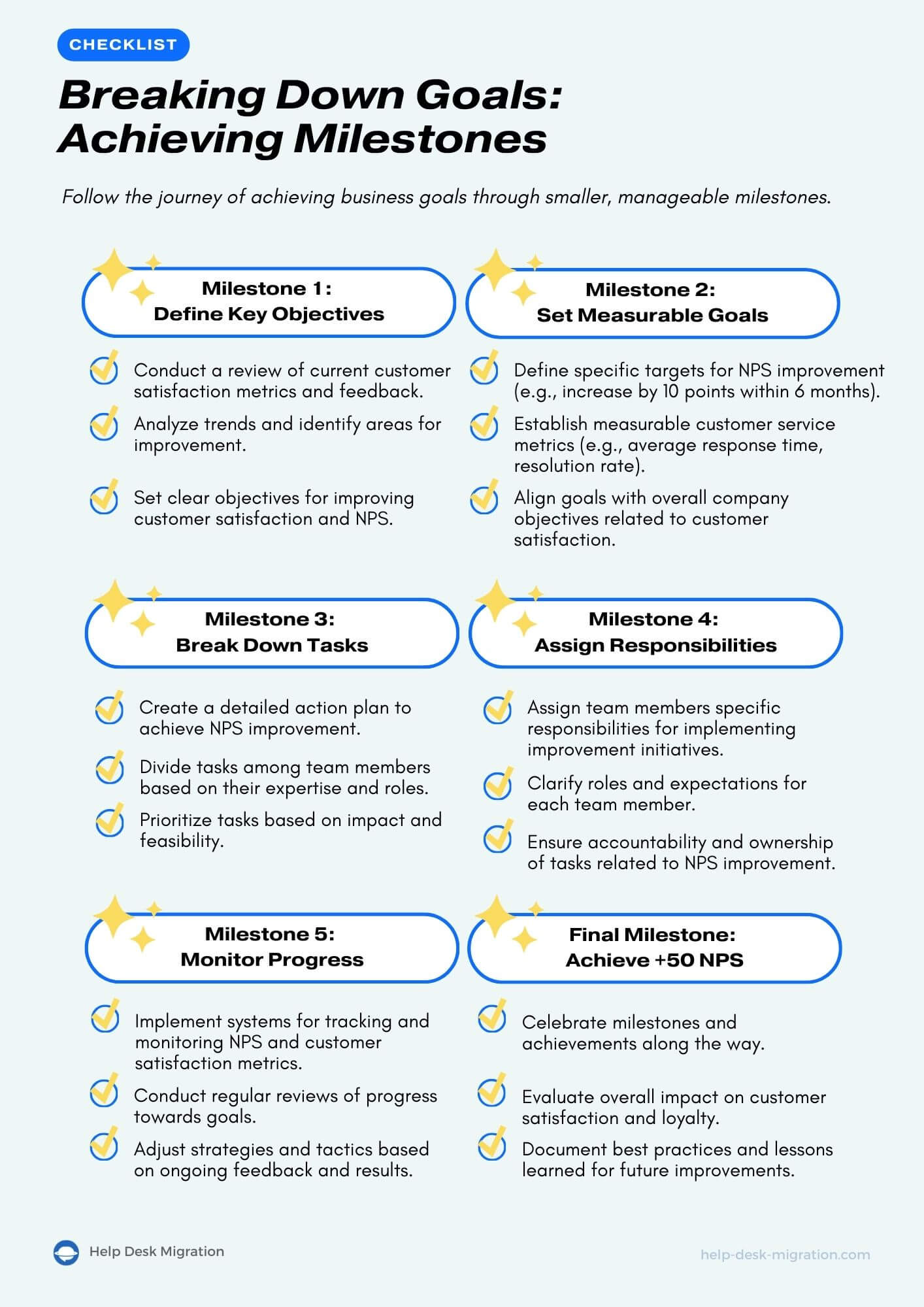
Team alignment
Without defined targets, your reps may give you different answers about what success looks like. One rep may say, “fast response times,” while another says, “thoroughly resolved issues, no matter how long it takes.” Will a team pulling in opposite directions be highly effective? Not really.
But with quantifiable goals, you don’t have to debate what “good service” actually means. No ifs, ands, or buts — you set the finish line everyone is working toward.
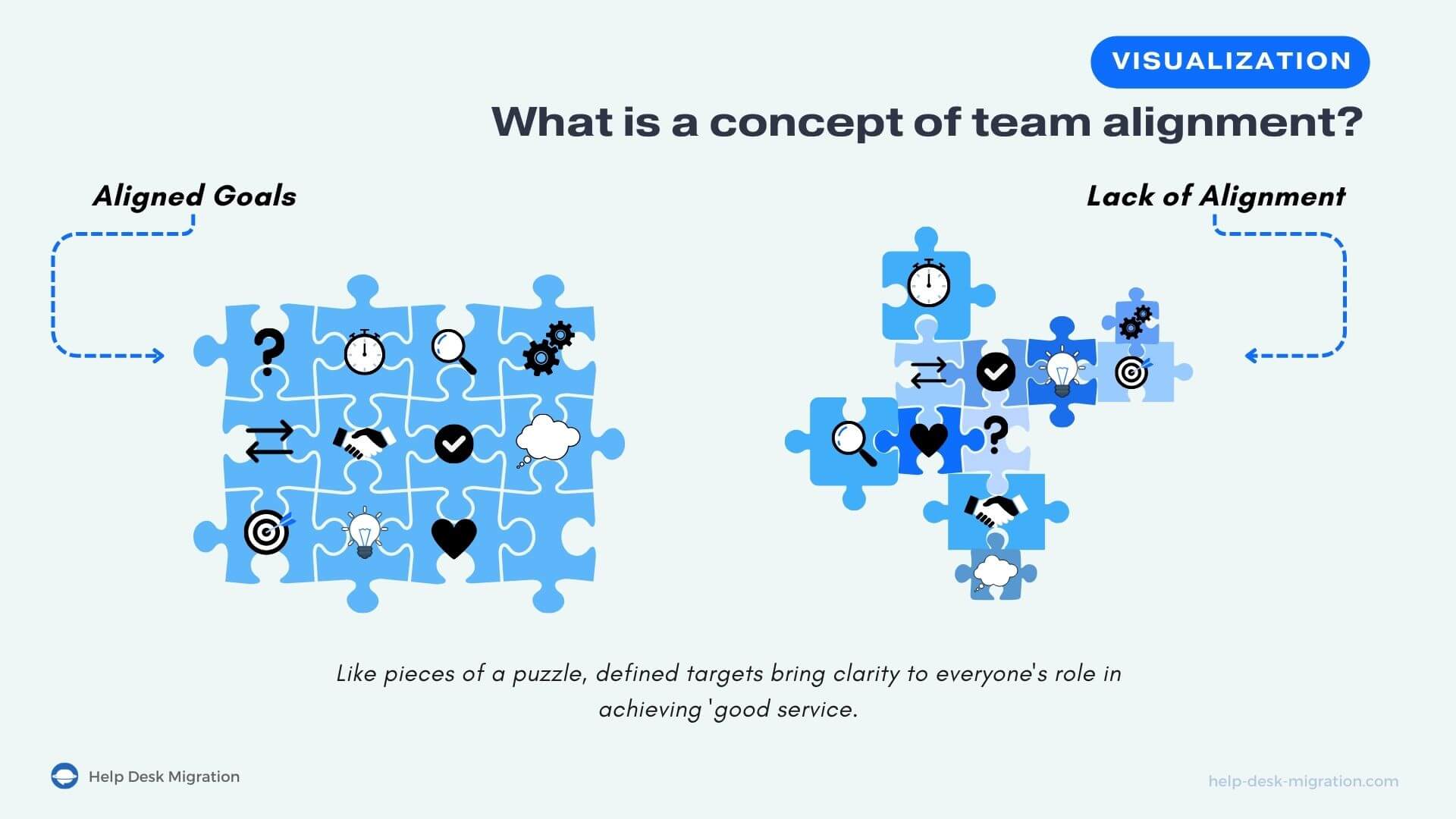
Connecting customer satisfaction goals to business impact
When you set measurable goals, you can connect them directly to the bigger metrics that impact your company’s bottom line. With concrete data points, you can correlate service performance to hard numbers like customer retention rates, upsells, and overall customer lifetime value. It also becomes much simpler to emphasize why meeting tactical customer service goals is so important.
Let's say one of your goals is keeping response times for premium customers under 30 minutes. That’s a good target in itself. But then you can also consider data showing customers enjoying responsive support have way lower churn rates. Now you can see how this result moves the needle for your business, not just for premium customers.

While there's certainly more to discuss about the upsides of measurable goals—like precise resource allocation or enabling continuous improvement—we've got a lot to cover in this article. Next, let's discuss the different types of support service goals.
What are the types of customer service goals
In a broad sense, all customer service goals fall into two types: strategic and tactical.
Strategic goals are more general and long-term. They keep the customer service department aligned with the company's mission. Strategic goals might include objectives like becoming the industry leader in customer satisfaction within five years. When setting strategic goals, companies often look at the competition, industry trends, and growth plans to make sure they’re challenging yet realistic.
Tactical goals are smaller and lead you toward strategic goals. They let you monitor your progress and make adjustments along the way. For example, a tactical goal for improving customer satisfaction could be to increase self-service resolution rates by 25% over the next six months through improving knowledge base content and implementing AI-powered virtual assistants.
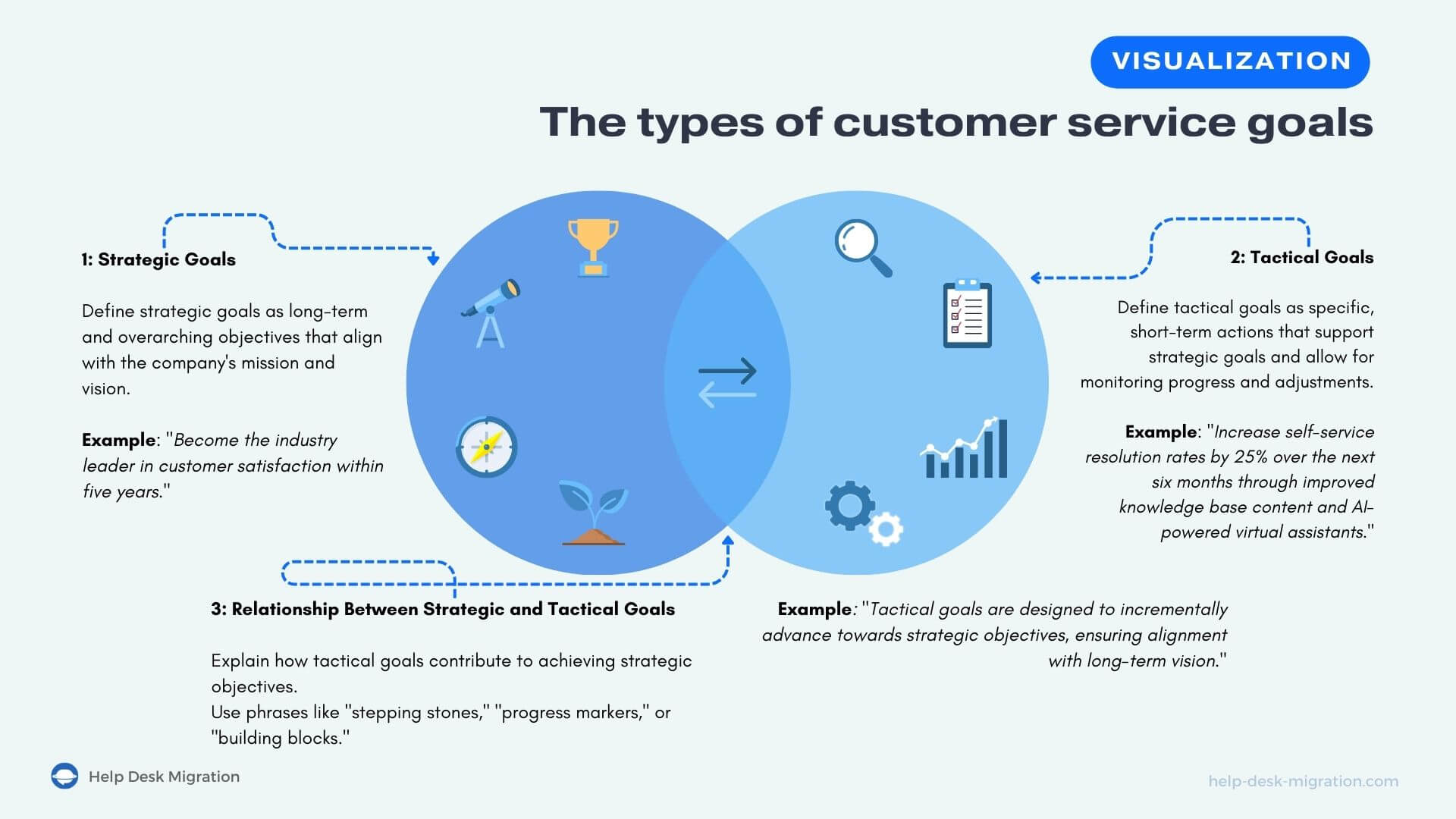
Both strategic and tactical goals come in different varieties, with each type serving a unique purpose in driving your business results:
Operational goals
Operational goals zero in on the details of the customer service team’s effectiveness. When you set operational goals, you typically use metrics like response times, resolution rate, average handling times, agent utilization rate, repeat contact rate, and beyond.
Customer satisfaction goals
While operational goals focus on the productivity of the customer service processes themselves, service quality goals relate to the customer's perception of the service experience they received. Here, you look at metrics like customer satisfaction score (CSAT) and NPS.
Training and development goals
With true professionals on board, any customer service goal are way more achievable. That’s why training and development goals are as important as operational and customer satisfaction ones.
Some examples of customer service goals for employees include having 75% of agents earn certification in conflict resolution by the end of the year or 90% satisfaction scores from reps on the relevancy of training content.
Financial goals
While there can be numerous tactical financial goals, there’s only one strategic goal — finding the right balance between an amazing service, its cost-efficiency, and the profit from it.
Financial goals might include targets for cost per contact, overall operational costs, and resource utilization. Some specific examples of financial goals are:
- Reduce average cost per contact by 8% through automation
- Use AI chatbots to handle 30% of basic inquiries by Q3
- Renegotiate 20% lower per-ticket costs with a current outsourcing partner
Measurable financial goals let you manage costs smartly while still providing excellent customer service. Speaking of doing things the smart way, let's unpack the SMART framework for goal setting.
The SMART framework explained
When you set goals for your customer service department, it's crucial to make them SMART. No, that’s not a random adjective — SMART is an acronym that stands for:
- Specific. As we’ve discovered, goals like “improve service” are utterly useless. For the best possible results, you need to be specific about what exactly you want to achieve. Does better service mean responding faster, getting higher satisfaction scores, or having more customers use self-service?
- Measurable. If you can't quantify and monitor your customer service progress, the impact of your efforts remains hypothetical. “Keep average handle times under ten minutes” is something you can track.
- Achievable. While being ambitious is great, unrealistic goals will just leave everyone frustrated. When setting targets, honestly assess your resources and starting point to ensure your goals are possible to reach.
- Relevant. Does improved CSAT for a low-revenue product line really matter? Although maximalists may be tempted to try to make everything perfect, preferably at once, priorities are important.
- Time-bound. Open-ended goals lack a sense of urgency. Adding clear deadlines, whether monthly, quarterly, or annually, creates accountability to drive action.
These SMART criteria will help you avoid ambiguous goal setting. Instead, you’ll create a roadmap with measurable milestones to track progress and optimize performance.
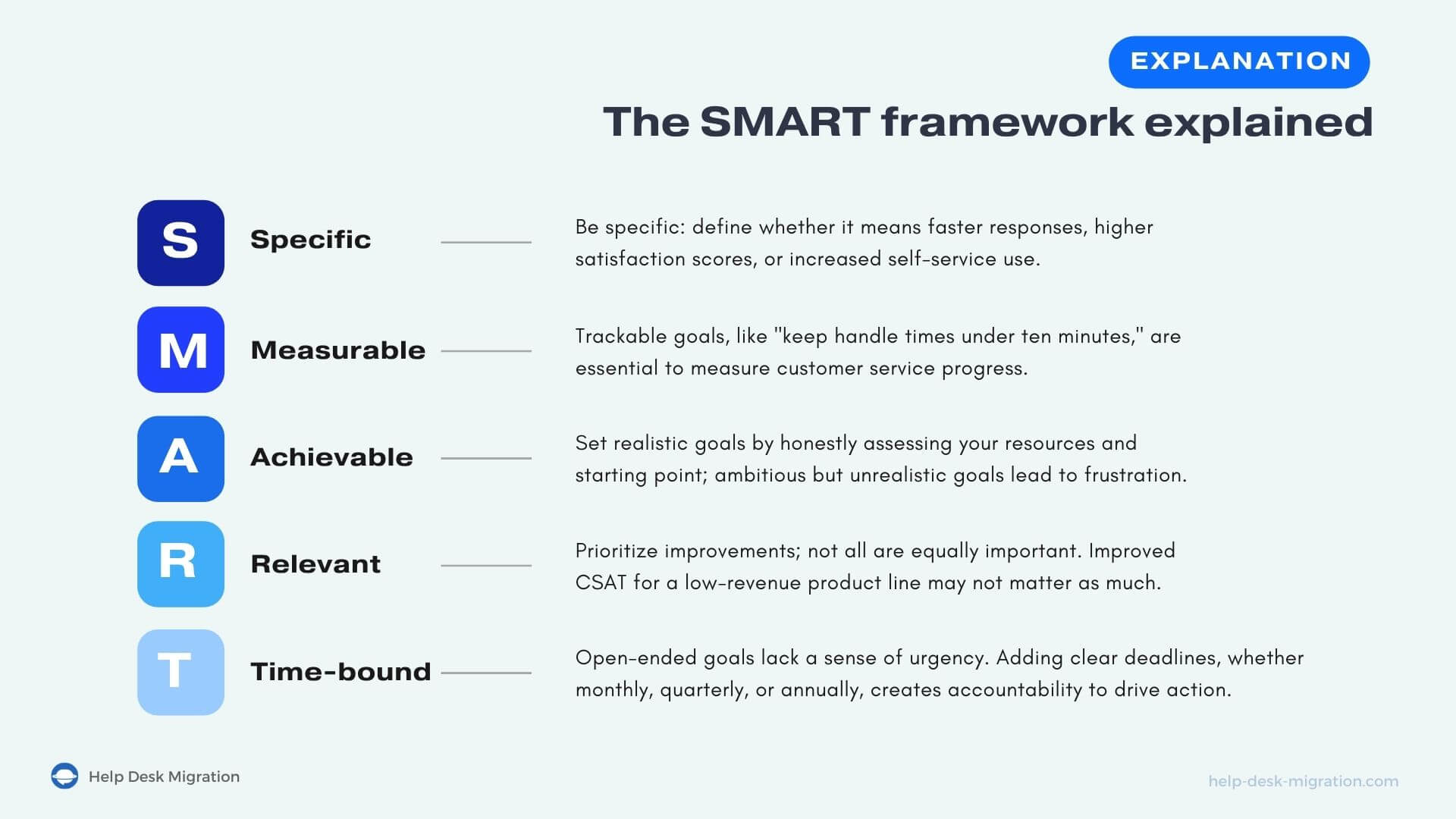
How to set SMART support service goals in 2026
Customers require more in 2026, according to 82% of service industry professionals. Knowing how to create measurable goals with clear metrics and timeframes lets you set actionable targets that align with current user demands. Take advantage of this checklist.
1. Conduct a comprehensive assessment
The first step is taking a look at your current operations. You need to collect data from multiple sources, like performance reports, customer surveys, and industry benchmarking studies. With this data on hand, you can determine your strengths, weaknesses, opportunities, and potential threats.
For instance, let's say you've noticed a worrying trend — customers have become more likely to cancel their subscriptions or not renew contracts. Looking at the data, you see that the biggest driver seems to be long wait times to get issues resolved, especially for more complex billing or technical inquiries.
As you dig deeper, the root causes become clear — your staff over relies on manual processes, having to enter customer details and issue information into ticketing systems themselves. What’s more, fulfilling common requests like password resets or order lookups still falls on their shoulders, too.
2. Define clear objectives
The next step is setting objectives for what exactly you want to accomplish.
In our example, to decrease customer churn your objectives can be: “Reduce wait times for complex issues” and “Automate basic requests via AI-powered chatbots.”
3. Identify KPIs
Once you know what you’re aiming for, you can define the core metrics that will assist you on your way to recovering the number of subscriptions. These KPIs give you numbers to follow over time, so you can see your progress toward your goals.
For the objective of reducing wait times for advanced tech support, some relevant metrics would be:
- Average speed to answer
- Percentage of calls answered within target timeframes
- Self-service containment rate for common tech issues
And here are some examples of KPIs for the goal of automating 100% of basic requests:
- Percentage of requests handled via self-service
- Automation deflection rate
- Agent time spent on manual password reset and order lookups
It's also wise to have a set of KPIs looking at multiple dimensions like operational efficiency, customer satisfaction, and revenue impacts where relevant. This way, you don’t just optimize for one piece of the puzzle. Plus, it’s also useful to define the specific data sources, measurement criteria, and reporting frequencies for each metric, so you can accurately track them.
4. Set benchmarks and targets
Now that the KPIs are identified, it's time to establish benchmarks and targets. Benchmarks show how others in your industry perform on similar KPIs. Suppose top companies typically answer 80% of complex tech support calls within ten minutes. The 80%/10-minute benchmark gives you a realistic standard to measure up against.
Targets, in turn, are the internal goals you set based on your situation and resources.
Using the external 80%/10-minute benchmark, you might set a target of answering 70% of calls within 12 minutes for the upcoming quarter. While not yet best-in-class, it's an ambitious and achievable goal and includes a set, clear timeframe.
5. Communicate goals effectively
Setting SMART customer support service goals is just the first step — getting your team invested in achieving these targets is what separates good intentions from great execution. While goals define the "what," agents also need clarity on why and how they'll contribute. They also need to be able to raise concerns, ask questions, and provide feedback to truly engage.
For instance, when boosting CSAT scores, your reps will likely have insightful ideas for quick-win improvements based on common customer issues they observe firsthand. Employees will be more motivated when their voices are heard.
And while your customer service team drives the work, leadership plays an indisputable role, too. When leaders constantly tie their communication and decision-making back to their core objectives, it reinforces their importance. Plus, other departmental initiatives and bureaucratic processes can easily get in the way. Therefore, redirect resources and make approval processes simpler — be the one who encourages the entire organization to feel a sense of unity and focus on what matters.
6. Implement continuous tracking and analysis
You've put a lot of effort into setting your goals. But once you proceed with their implementation, you’ll require mechanisms to understand if you're actually succeeding. Data tracking and analysis come in handy here. First, make sure your customer service data isn’t scattered and can be accessed from a single, easy-to-understand dashboard.
You may need to integrate data from CRM systems, ticketing tools, customer surveys, workforce scheduling, and more. Or, to avoid struggling with multiple integrations, you could migrate to an all-in-one help desk. This way, all your vital customer data, case details, service metrics, agent activities, and knowledge base content will live in a centralized hub, giving you complete visibility down to the finest details.
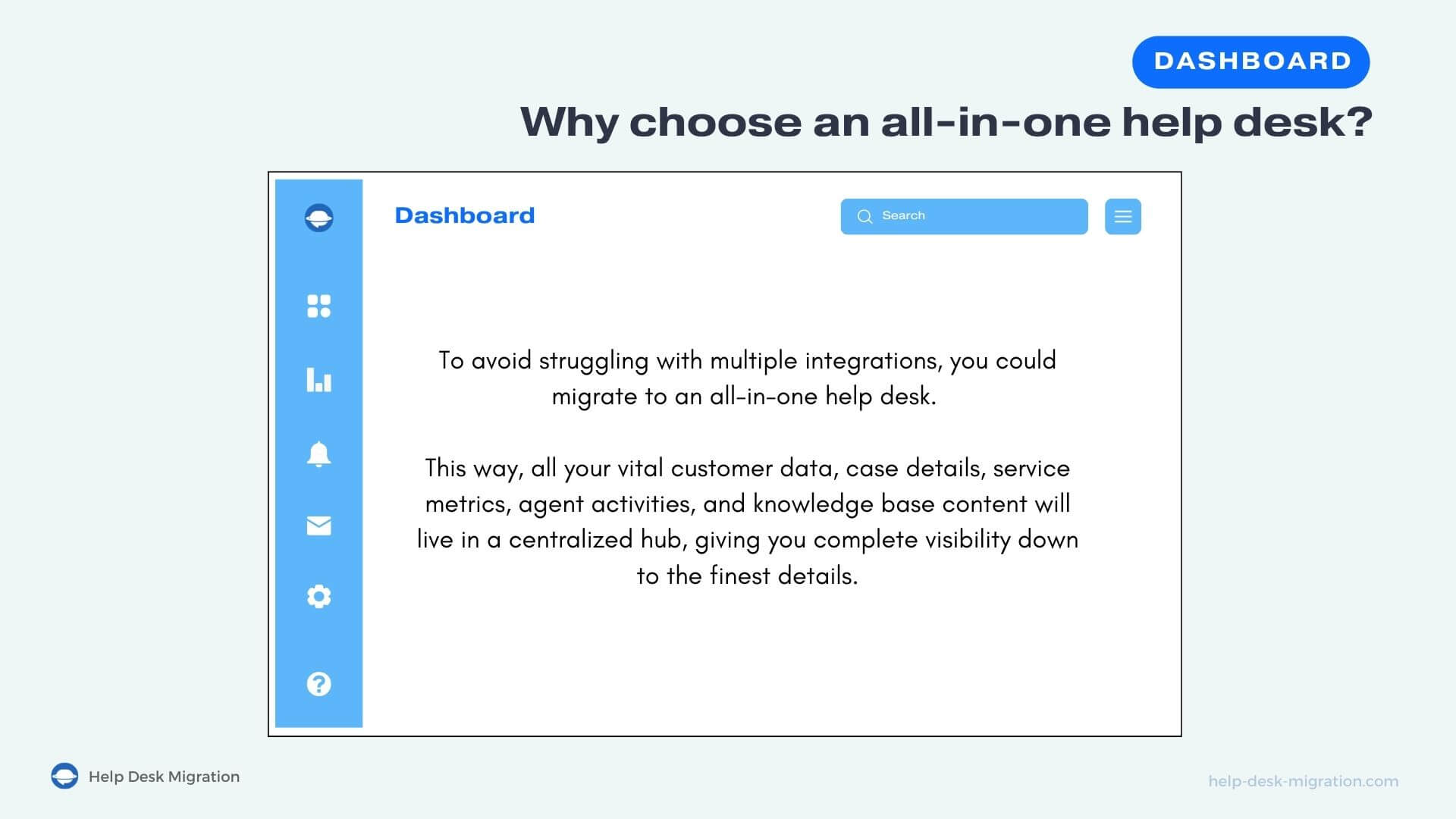
And as your needs evolve, the right system will be able to scale along with your business. You can add more KPIs to track, like service level adherence, sentiment analysis of conversations, schedule efficiency, channel cost analysis, and cost of downtime. Moreover, with in-built AI, you’ll be able to forecast future service department loads and model “what-if” scenarios.
Only through rigorous measurement can you validate whether your customer service goals are translating into meaningful business results. If you’re ready to set SMART goals and follow the checklist introduced above, we’ve also prepared some hints for you — examples of goals that might be useful to your organization.
7 Essential customer service goal examples
While most businesses' big-picture goals are generally similar — boosting loyalty and driving revenue — below are some tactical goals, particularly for customer service, that can help you hit larger targets.
1 Enhance service technology
Automation is a cornerstone of effective customer service performance, as well as the performance of the overall organization. In fact, it’s one of the main goals on the agenda for customer service teams in 2026. Quite often, the root of customer service issues boils down to a lack of automation. What’s the point of entering customer data by hand when it can be automatically added to your database once the ticket is submitted?
So, on top of just tracking progress, a reliable tech foundation can help you overcome hurdles to achieving your goals. Let's go back to the example of declining subscriptions. With robust software in place, you could automate as many routine tasks as possible, letting your team focus on more complex cases that directly impact retention and revenue.
2 Improve the agent experience
If the customer service tools are clunky or agents don't get proper training, all of the automation benefits are just bells and whistles. Agents might end up doing tasks manually anyway.
So, user-friendly interfaces, quality training, and ongoing support are critical to ensuring agents actually use these tools to their full potential.
3 Go omnichannel
Omnichannel customer service is a tactical goal companies can't afford to ignore. The more channels you provide for customers to get support — whether by phone, email, chat, social media, or other methods — the more accessible options you have to resolve issues quickly through their preferred method of communication. But remember to unify your channels so your agents have a complete view of the conversation history, no matter which channel the customer uses.
4 Provide mobile-friendly support
Customers increasingly need on-the-go support, and it has already become an expected standard of service.
Now, there’s a clear tendency for service organizations to adopt messenger apps. When users can easily get help from their phones, it reduces many of the frustrations that cause them to ditch your product out of inconvenience. So, make sure you deliver frictionless mobile support, so there will be more chances of customers happily renewing a subscription with you again and again.
5 Collect customer feedback
One of the best ways to reach your customer satisfaction goals is by going straight to the source — collecting customer feedback through surveys or other channels. You’ll be able to understand real needs, pain points, and opportunities to better tailor your services to customer preferences.
6 Offer self-service options
Instead of waiting on hold for an agent, your customers could take advantage of knowledge bases, chatbots, and community forums to find their answers independently. Over 60% of customers prefer to help themselves with basic problems.
Top companies like Atlassian, Zendesk, and Freshworks have created vibrant online communities for their end users (service agents) to help each other. You could implement a similar solution for your product, as it can greatly reduce the burden on your support staff, who would otherwise have to personally respond to every routine inquiry. Plus, peer-to-peer assistance actually improves the perception of your brand since it shows other people actively use your product, too.
7 Reduce cost per contact
While keeping customers happy is a priority, operational cost reduction isn’t a less significant goal for businesses. Controlling expenses and cutting unnecessary costs directly impacts the bottom line. Automation is one of the main answers here, too. By automating repetitive tasks, you need fewer human agents to handle simple requests.
Addressing challenges in achieving customer service goals
Customer service is a battleground where businesses fight to win loyalty and satisfaction. But the path to excellence is riddled with formidable challenges that demand strategic finesse and relentless determination:
- Rising Customer Expectations: Today's customers aren't merely demanding; they're expecting miracles. They want service that's not just fast but anticipatory, personalized to the T. Meeting these sky-high expectations requires a blend of art and science.
- Technology Tangles: While tech promises efficiency, it often introduces its own complexities. Integrating diverse systems, ensuring they play nice together, and keeping up with tech's rapid evolution can feel like untangling a particularly knotty problem.
- The Human Element: Behind every ticket or tweet lies a human story. Training and retaining a team that can handle everything from tricky queries to tense moments with grace and empathy is an ongoing challenge.
- Data Deluge: Swimming in data but thirsty for insights? Making sense of mountains of customer information, safeguarding privacy, and using data effectively without drowning in it requires not just tools but a savvy strategy.
- Scaling Sprints: Growing pains hit hard in customer service. What works for a handful of clients may buckle under the weight of rapid scaling. Balancing growth with quality service demands agility and foresight.
- Crisis Control: In today's hyper-connected world, one misstep can spark a wildfire of negative publicity. Navigating crises with speed, transparency, and integrity is essential to safeguarding brand reputation.
Tackling these challenges isn't just about survival—it's about crafting a customer service experience that delights, builds loyalty, and sets your brand apart in a crowded marketplace. It's about turning obstacles into opportunities and transforming each interaction into a testament to your commitment to excellence.
The path to purposeful customer experiences
Setting measurable customer service goals is about intentionally designing experiences that make customers happy and keep them coming back. The right goals tie every customer interaction to real impacts on retention, operational efficiency, and revenue. They hold every team member accountable and give your customer service department one common objective to work toward together. But most importantly, these goals allow you to spot areas for help desk improvement and make smart decisions. What gets measured gets improved.
Once you know how to set up customer service goals in 2026, the question remains — how do you achieve them? Automate, automate, and automate again. While customer service software isn’t a panacea, it’s a great solution to the majority of challenges customer service departments face in 2026. The right help desk system can let you reach your current goals and pursue the ones that may seem like only a dream today.
FAQs
Setting measurable customer service goals offers several key benefits:
- Clarity and focus: Establishing clear targets, such as “increase customer satisfaction scores by 10% over six months,” provides your team with specific objectives to work towards.
- Improved performance: Measurable goals enable progress tracking and highlight areas for improvement. For example, a goal like “reduce average response time to under 1 hour” sets a clear benchmark for performance evaluation.
- Enhanced accountability: Clear, measurable goals define expectations for team members. A target such as “resolve 90% of customer complaints within 24 hours” helps in assessing individual contributions.
- Motivation and engagement: Well-defined goals, such as “increase first-contact resolution rate by 15%,” can boost team motivation and focus on achieving shared objectives.
- Strategic alignment: Setting customer service objectives ensures that efforts align with broader business goals. For instance, a goal like “achieve a 95% customer satisfaction rating” supports the company’s commitment to high-quality service.
Companies should review customer service goals regularly to ensure they remain relevant and effective:
- Monthly or quarterly: Reviews: Conducting reviews on a monthly or quarterly basis helps track progress and make necessary adjustments. For instance, a review might involve evaluating progress towards goals such as “reduce customer wait times by 15%.”
- Annual reviews: At a minimum, goals should be assessed annually to evaluate overall performance and set new objectives for the coming year. Reviewing past customer satisfaction goals can guide the development of new targets for the future.
Here are some key customer service objectives and goals examples for 2026: :
- Personalized customer experiences: In 2026, goals will focus on creating personalized support, such as using AI to provide tailored solutions for 80% of customer interactions.
- Omnichannel support: Goals will include providing a consistent experience across all channels, ensuring all customer service channels work together seamlessly.
- Proactive service: The focus will shift to anticipating issues before they happen, creating systems to identify and solve problems before customers reach out for help.
- Advanced analytics: Goals will involve using advanced analytics for better insights, adopting predictive tools to forecast customer needs and increase satisfaction scores by 15%.
- Sustainability initiatives: There will be a stronger focus on sustainability, aiming to cut the environmental impact of customer service operations by 20%.
To set measurable goals for your customer service team, follow these steps:
- Define clear objectives: Start with clear customer service smart goals. For example, “increase the customer satisfaction score from 80% to 90% in the next quarter.”
- Use specific metrics: Establish metrics that are quantifiable and specific. Examples include “decrease average response time from 2 hours to 1 hour” or “increase first contact resolution rate by 10%.”
- Set achievable targets: Ensure that goals are challenging but attainable. For instance, setting a goal like “resolve 95% of customer issues within 48 hours” is realistic and achievable.
- Track progress regularly: Implement a system for monitoring and reviewing progress. Use tools to track metrics such as “number of resolved tickets” or “customer satisfaction ratings.”
- Communicate expectations: Make sure that you clearly communicate the goals to your team. For example, “discuss monthly progress on achieving goals such as reducing customer wait times.”
Here are some customer service goals examples:
- Increase customer satisfaction: Raise the customer satisfaction rating from 85% to 90% within six months.
- Reduce response times: Cut down average response time from 24 hours to 12 hours.
- Improve first contact resolution: Achieve a 75% first contact resolution rate within the next quarter.
- Enhance customer retention: Increase customer retention rates by 10% over the year.
- Boost customer service efficiency: Increase the number of resolved tickets per agent per day by 20%.
Good measurable goals for customer service are specific, achievable, relevant, and time-bound. Here are smart goals for customer service examples:
1. Decrease complaint resolution time:
- Goal: Reduce average complaint resolution time from 48 hours to 24 hours within six months.
- Details: Optimize workflows and empower agents with the authority to resolve issues faster.
2. Increase Net Promoter Score (NPS):
- Goal: Raise the Net Promoter Score from 60 to 75 within one year.
- Details: Focus on improving overall customer experience and addressing feedback from detractors.
3. Improve customer service efficiency:
- Goal: Increase the number of resolved tickets per agent per day by 20% within the next quarter.
- Details: Implement new tools and training to enhance productivity and efficiency of customer service agents.
4. Enhance knowledge base usage:
- Goal: Increase the usage of the knowledge base by customers by 30% in the next six months.
- Details: Improve the quality and accessibility of self-service resources to reduce the need for direct support.
5. Boost employee training and development:
- Goal: Ensure that 100% of customer service agents complete a new training program within the next quarter.
- Details: Develop and implement a comprehensive training program to improve skills and service quality.



